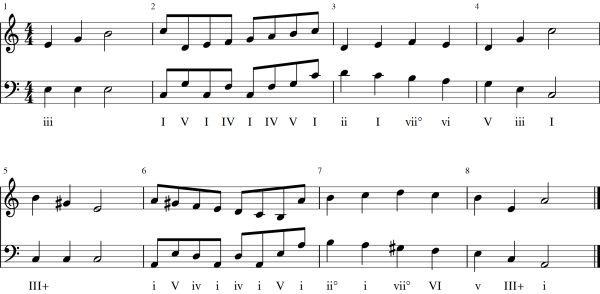Audio: chord progression (0:16)

chord progression plays chord progressions on a bassoon and an oboe. The chord progression figure shows the score. The bassoon in the bass part plays the root of each chord and the oboe in the upper part plays the root, the third above the root, or the fifth above the root. Bars 1-4 are in the key of C major and bars 5-8 are in the key of A harmonic minor. The chord progressions are as follows:
A chord progression is a succession of root notes.
A chord progression represents the dynamic element of harmony. It focusses on how chords relate to each other and move through time.
To write a chord progression, decide how the root note should proceed. There is no precedence among root movements but a useful tip is to use this order: by repeat, by fifth, by step then by third.
A repeat root is perfectly acceptable in a chord progression. This is in direct contrast to a repeat note in a melody, which would ring a warning bell. The motion of a root is not the same as the motion of a melody because a root progression is a way of connecting chords together whereas melodic motion is a way of connecting notes together. A single melody has to move to make it interesting. A chord does not have to move, it can be made interesting by rearranging the notes that comprise the chord. The more notes there are in a chord the more ways there are to rearrange them and continue repeating the root.
Root progression by fifth up or down is movement according to the circle of fifths. It is the most popular type of root motion. An awful lot of harmony consists of root progression by fifth.
Two consecutive fifths form a compound interval of a tenth which, in turn, reduces to a simple interval of a second, a step. Root motion by step up or down is the most popular root progression after movement by fifth. Two chords a step apart share no notes in common, so step motion is a method for providing a strong contrast in a chord progression.
Three consecutive fifths reduce to a simple interval of a sixth, the inverse of a third. Root progression by third up or down is the least common of the root motions. This is because tertian harmony builds chords from thirds and root progression by third will often result in only one changed note so the impact is much less marked than progression by fifth and by step.
Root progression is the mechanism by which chords relate to each other through a chord progression. Every chord has a root, and chords relate to each other because a chord progression is a succession of root notes.
Expanding a single chord into a progression is the simplest and most effective way to develop a harmony. Take, the single chord, I, for example. Repeating it in a I-I-I progression produces a mildly interesting harmony. Expanding it into a I-IV-V progression develops the harmony significantly. Any chord in a progression can be targeted for expansion into a larger progression, and, in this simple way, it is easy to quickly design a chord progression for a single piece of music.
Finally, we can return to a general issue in harmony and put to bed the debate about whether a chord has to have a minimum of two notes or three. A chord is constructed from intervals and a single interval is enough to construct a chord with two notes. Two notes are sufficient to classify a chord as consonant or dissonant, three notes are needed to determine whether the chord is a major or a minor chord. A succession of root notes constitutes a chord progression regardless of the number of notes in each chord.
Ergo, case proven, it is official: an interval is a chord.
The remainder of this section concentrates on those issues of chordal harmony that solely affect chords with three and more notes.